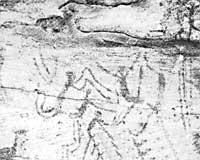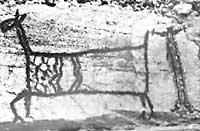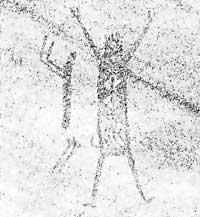When did man first arrive in America?
1987/06/01 Juandaburre, B. Iturria: Elhuyar aldizkaria


We ourselves, Homo Sapiens Sapiens, were born about one hundred thousand years ago in Africa and 40,000 years ago are dispersed by Africa, Europe, Asia and Australia. For about ten millennia we lived with the man of Neandertal (Homo sapiens neanderthalensis). But 35,000 to 40,000 years ago, homo sapiens sapiens was imposed on all other hominids in Europe, Africa, Asia and Australia.
And in America what? It was then inaccessible to primitive men. Despite being very sapiens, it is difficult to think that they managed to cross the Pacific Ocean or the Atlantic. What if in an ice cream they crossed the Bering Strait? When the temperature fell, much of the water that evaporates to the seas, instead of returning it in the form of rain, accumulated in the form of ice and snow. The water level decreased and the Bering Strait became a conflict. In this situation these primitive explorers could move from Asia to America. However, they found the second obstacle: From Bare to the Atlantic (in the area of Canada today), with an imposing ice barrier.
The oldest known human remains in America are about 12,000 years old. According to this data, it seems that the colonization of America began later than that of other continents, at the end of the last glaciation.
The first settlers were the Mongols of Siberia, from the valley of Lena, who after crossing the bridge of the Berin Strait, managed to cross the Canadian ice barrier through an open catwalk. The post-glaciation heat facilitated a quick breeze throughout the Contingent.
This is the idea that is assumed from the beginning of the century. This idea is very adequate to the ecological situation that can be assumed for those times. The ice cream had its maximum, 18,000 years ago. Persistent climate warming began 13,000 years ago. This caused the rise of marine waters and the waters cut the isthmus of Beringo 10,000 years ago. The human groups that hunted the mammoth had about 3,000 years to cross the isthmus and reach Alaska. The dispersion throughout America, therefore, was a time problem.
However, this chronology is being abandoned due to the cause of the last anthropological and archaeological data. Carbon dating methods indicate that man lived in South America 32,000 years ago. In addition, paintings from 15,000-20,000 years ago have been found in different places in South America. At the same time as Ekain painted the ancestors of the Basques, Inken worked on the same work.
The review of ideas on the colonization of America began 13 years ago. Then, a group of French and Brazilian anthropologists started working in the Pedra Furada (Perforated Stone), northeast of Brazil. This place, full of human remains, is considered the largest deposit in the world. Pedra Furada is the town that collects the footprint and waste accumulated for thousands of years. The tracks collected in it were systematically dated with carbon 14, and last year a wooden carbon sample gave an age of 32.160 ±100 years. This data was confirmed by another sample taken from a painted stone falling from the wall.
On the other hand, the North American anthropologist Thomas Dillehay has made another similar discovery on Mexico's Monte Verde, with 33,000 year-old wooden balloons, carved stones and charcoal.

According to these and other data, it seems that emigration to America occurred before schedule, 32,000 years ago, according to some. Others also consider that the proposed path is uncertain.
What is that way? Norwegian explorer Thor Heyerdahl says these primitive colonizers crossed the Pacific Ocean by boat. Although at first it seems like a surprising idea, it must be taken into account. The men who colonized Australia had to go through boats. Between Asia and Australia there was a narrow 100 kilometers wide. Another example is that of the Polynesia that colonized the Pacific islands more than 3,500 years ago. However, to think that 40,000 years ago these primitive men could cross the Pacific Ocean or the Atlantic from one end to the other with simple ships, is difficult.
To think that the first men of America came by Alaska seems more correct. However, the emigration took place before the foreseen.
The quaternary era began 127,000 years ago and there came a period of heat that lasted about ten thousand years. Subsequently, 100,000 years ago an ice cream reduced sea level 70 m. The episodes of heat and blackout happened rotatively until the arrival of the great ice cream that occurred 75,000 years ago. This lasted fifteen thousand years. 62,000 thousand years ago it was possible to continue walking from Siberia to Alaska. Two thousand years later it was absolutely impossible. Below are other glaciations (-52,000 and -40,000 years) before the last great ice cream that began 28,000 years ago.
About 35,000 years ago the man was in America. Later he spent the Isthmus of Bering in an ice cream that began 40,000 years ago and ended five thousand years later. But what kind of homo sapiens was? Sapiens sapiens or sapiens neanderthalensis? At that time both lived together.
The latter, like the others, wore costumes, worked stones, burned food to the fire… How was the first man of America then? Was there one or more waves of immigration? As long as your bones are not found, all these questions will remain in the air.

Gai honi buruzko eduki gehiago
Elhuyarrek garatutako teknologia





